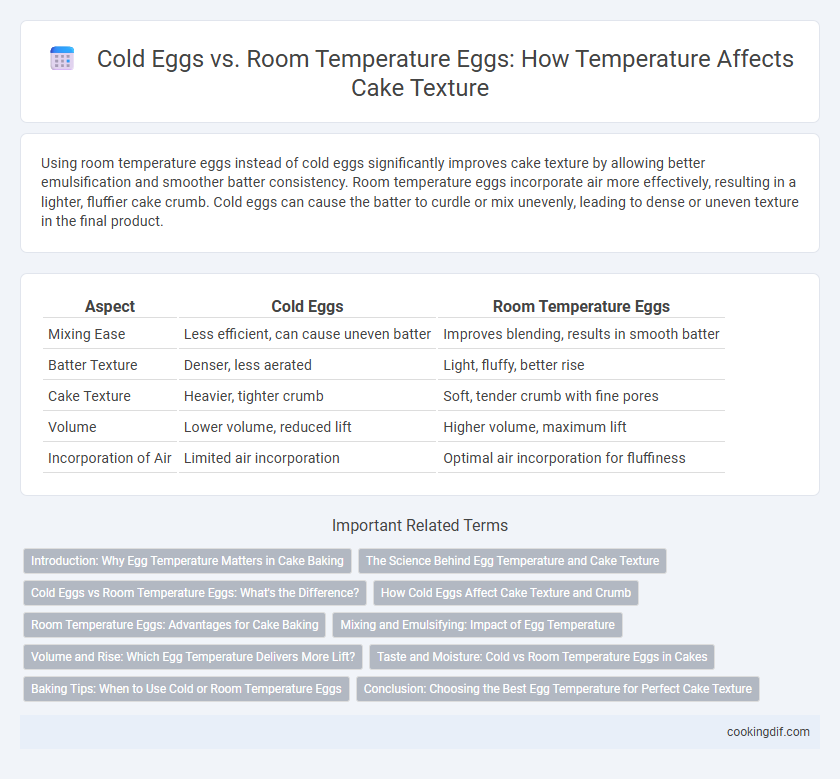Using room temperature eggs instead of cold eggs significantly improves cake texture by allowing better emulsification and smoother batter consistency. Room temperature eggs incorporate air more effectively, resulting in a lighter, fluffier cake crumb. Cold eggs can cause the batter to curdle or mix unevenly, leading to dense or uneven texture in the final product.
Table of Comparison
| Aspect | Cold Eggs | Room Temperature Eggs |
|---|---|---|
| Mixing Ease | Less efficient, can cause uneven batter | Improves blending, results in smooth batter |
| Batter Texture | Denser, less aerated | Light, fluffy, better rise |
| Cake Texture | Heavier, tighter crumb | Soft, tender crumb with fine pores |
| Volume | Lower volume, reduced lift | Higher volume, maximum lift |
| Incorporation of Air | Limited air incorporation | Optimal air incorporation for fluffiness |
Introduction: Why Egg Temperature Matters in Cake Baking
Egg temperature significantly affects cake texture by influencing how well ingredients blend and incorporate air. Cold eggs can cause batter to curdle or mix unevenly, leading to denser, less tender cakes. Using room temperature eggs promotes better emulsification, resulting in a lighter, fluffier crumb and consistent rise.
The Science Behind Egg Temperature and Cake Texture
Egg temperature affects the emulsion and aeration in cake batter, with room temperature eggs blending more easily with fats and sugars to create a smoother, more stable mixture. Cold eggs can cause butter to seize or curdle, leading to uneven texture and denser crumb structures. Scientific studies show that warmer eggs increase butter's plasticity, improving air incorporation and resulting in lighter, fluffier cakes.
Cold Eggs vs Room Temperature Eggs: What's the Difference?
Cold eggs can hinder the emulsification process in cake batter, leading to denser, less tender cakes, while room temperature eggs blend more smoothly, promoting better volume and lighter texture. Room temperature eggs incorporate air more efficiently during mixing, resulting in a fluffier crumb and improved rise. Using room temperature eggs is essential for achieving optimal cake structure and moistness.
How Cold Eggs Affect Cake Texture and Crumb
Cold eggs can cause uneven batter mixing, resulting in a denser cake texture and less tender crumb. The lower temperature slows down the emulsification process, preventing proper incorporation of air and fat, which reduces the cake's lightness. Using room temperature eggs ensures smoother batter consistency, promoting a finer, fluffier crumb and enhanced cake rise.
Room Temperature Eggs: Advantages for Cake Baking
Room temperature eggs blend more uniformly with other ingredients, promoting a consistent batter texture that results in lighter and fluffier cakes. They also trap air more effectively during whipping, enhancing volume and helping the cake rise better. Using room temperature eggs improves emulsification, ensuring smoother cakes with finer crumb structures.
Mixing and Emulsifying: Impact of Egg Temperature
Room temperature eggs mix more evenly into batter, promoting better emulsification and smoother texture in cakes. Cold eggs can cause fat to solidify, resulting in uneven mixing and denser crumb structures. Emulsification efficiency with room temperature eggs enhances air incorporation, contributing to lighter, fluffier cake texture.
Volume and Rise: Which Egg Temperature Delivers More Lift?
Room temperature eggs create more volume and lift in cake batter due to their ability to trap air more effectively when whipped. Cold eggs resist aeration, resulting in denser batters with less rise and lighter texture. For maximum cake volume and optimal crumb structure, using eggs at room temperature is essential.
Taste and Moisture: Cold vs Room Temperature Eggs in Cakes
Room temperature eggs blend more evenly into cake batter, enhancing moisture retention and creating a tender crumb with better texture. Cold eggs can cause the batter to curdle, leading to uneven texture and a denser cake with less moisture. Using room temperature eggs contributes to a richer taste by improving overall emulsification and moisture distribution in baked cakes.
Baking Tips: When to Use Cold or Room Temperature Eggs
Room temperature eggs blend more easily with other ingredients, promoting a smoother batter and resulting in a lighter, fluffier cake texture. Cold eggs can cause the batter to curdle or mix unevenly, leading to denser cakes and inconsistent crumb structure. For optimal baking results, use room temperature eggs in recipes requiring creaming butter and sugar, while cold eggs can be suitable for recipes where ingredients are mixed quickly or chilled, such as sponge cakes or certain cookie doughs.
Conclusion: Choosing the Best Egg Temperature for Perfect Cake Texture
Using room temperature eggs in cake batter promotes better emulsification and results in a smoother, lighter texture due to improved incorporation of air and fat. Cold eggs can cause uneven mixing, leading to denser, tougher cakes with potential curdling. For optimal cake texture, always choose room temperature eggs to enhance volume and achieve a tender crumb.
Cold eggs vs Room temperature eggs for texture Infographic

 cookingdif.com
cookingdif.com